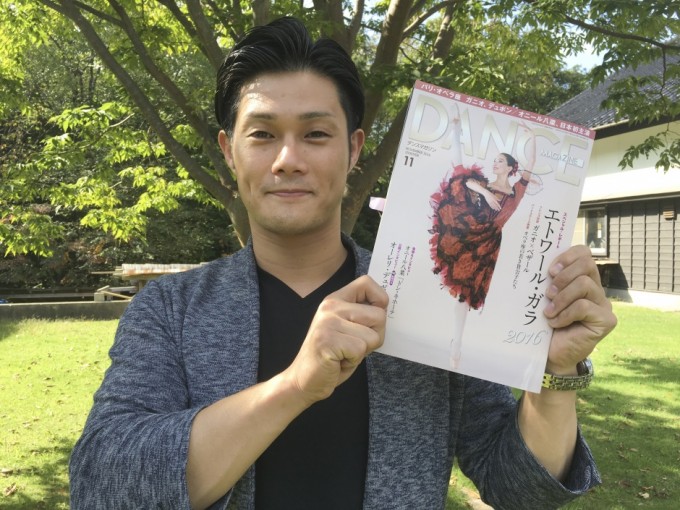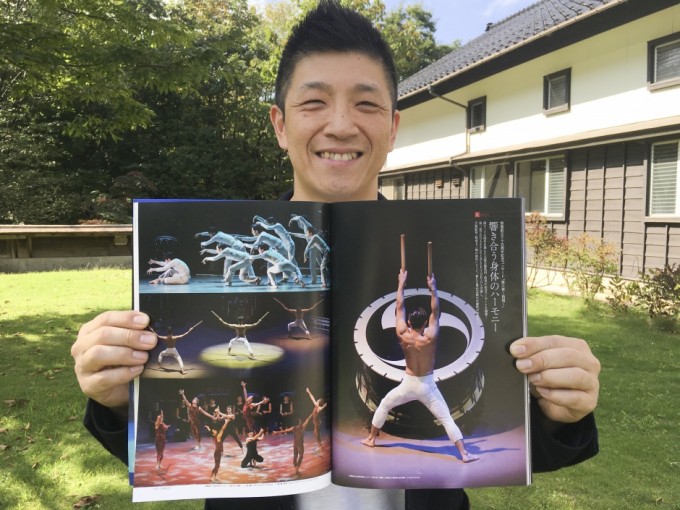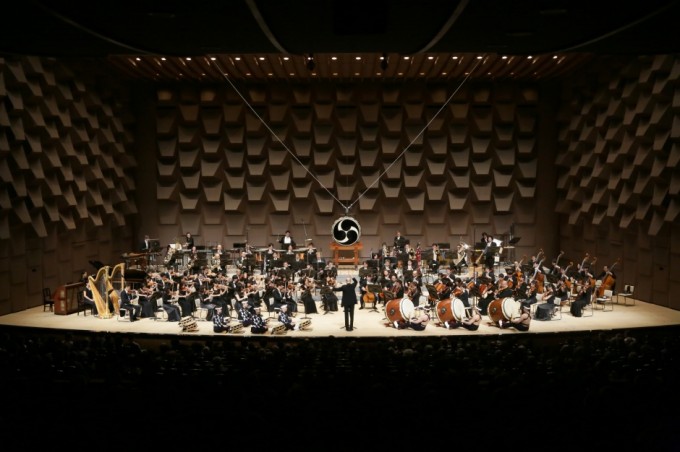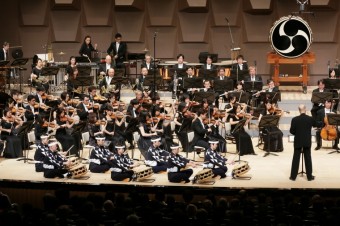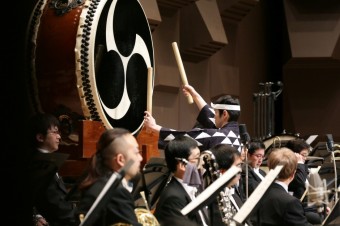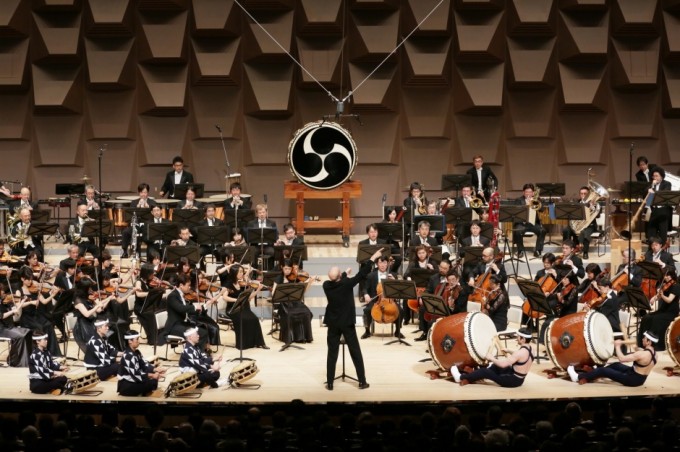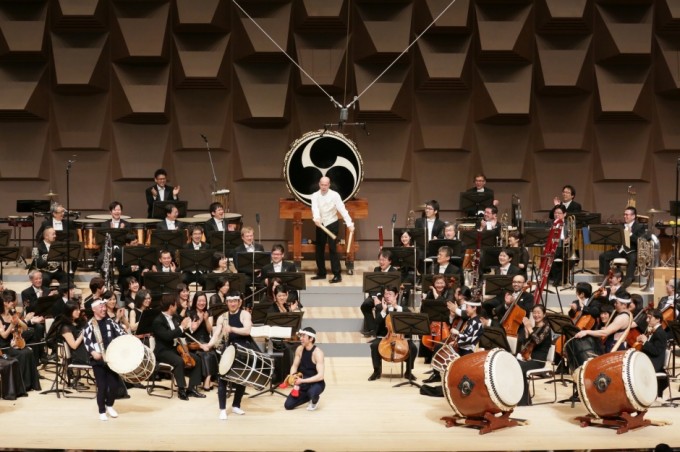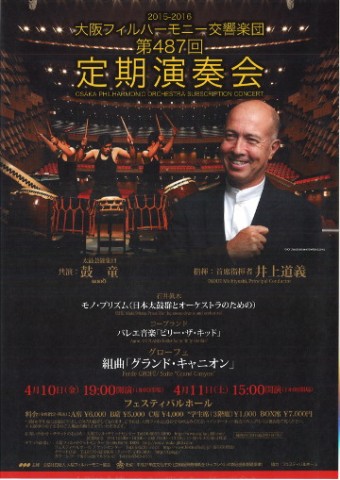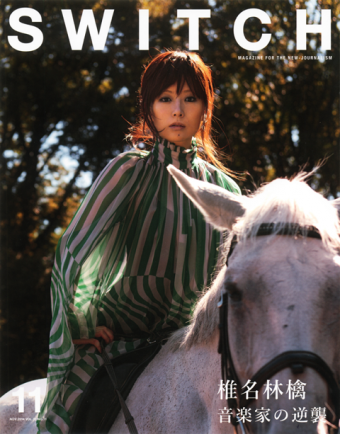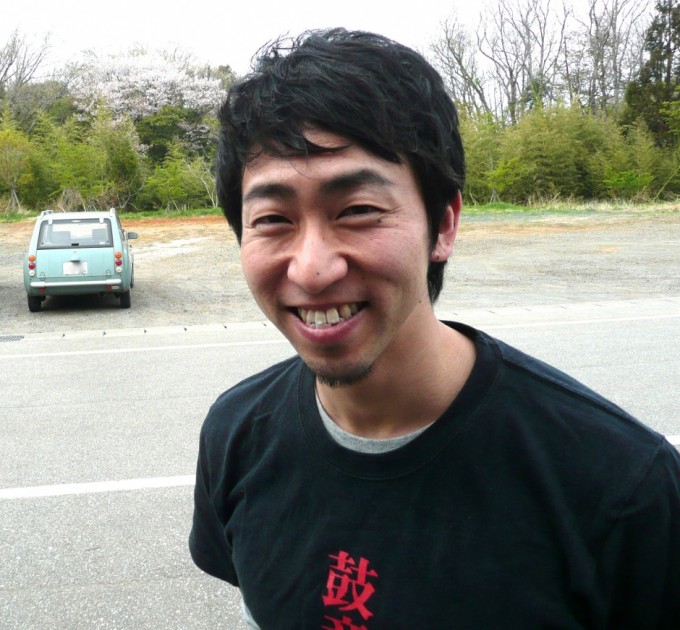Articles & Interviews
Kodo Featured in Nov. 2016 Issue of “Dance Magazine”
Kodo Featured in Nov. 2016 Issue of “Dance Magazine”
If you’re in Japan, keep an eye out for the November issue of “Dance Magazine.” It has a special feature on Kodo’s 35th Anniversary Concert “Hisho” (Soaring) with Blue Tokyo & Dazzle. It’s on sale now!
Photos: Masayuki Sakamoto (above) and Yuichiro Funabashi at Kodo Village holding the Nov. 2016 issue of Dance Magazine. They just got back from Korea.
“Dance Magazine” Nov. 2016 Issue
http://www.shinshokan.co.jp/dance/index_dance.html
Kodo 35th Anniversary Commemorative Concert “Third Night ‘Hisho’–Soaring–”
Packed with a diverse array of powerful performances, the first act of Hisho features Kodo performing the compositions of Tamasaburo Bando. For the second act, Bando directs Kodo as they collaborate with two unique dance ensembles: the male rhythmic gymnastics troupe Blue Tokyo, and the street dance performance group Dazzle.
Mitsuru Ishizuka: An Interview by Johnny Wales
Mitsuru Ishizuka: An Interview by Johnny Wales
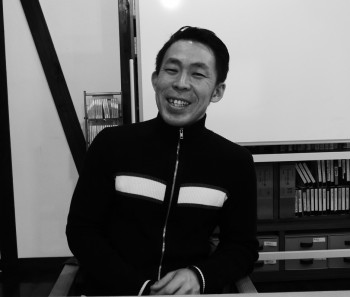
Mitsuru during his interview at Kodo Village (Photo by Johnny Wales)
His father is a founding member of the pioneering Sukeroku Daiko, his older brother and younger sister are professional taikoists and his younger brother is an apprentice taiko maker. Mitsuru made his first appearance on stage at age five, and yet at the beginning of his second year as a Kodo apprentice, he decided to forget everything he had ever learned about taiko…and begin again from zero.
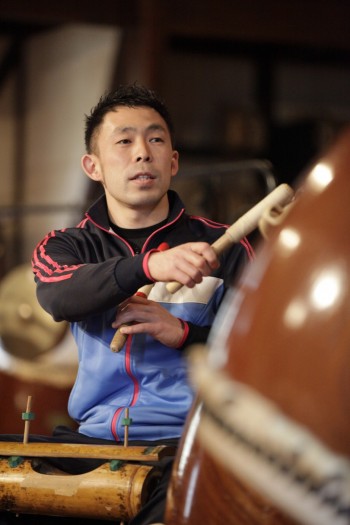
Mitsuru was born into a world of taiko in Tokyo on August 6th, 1979. At the age of 4 his parents moved the family to a mountainside in Saitama believing it would be a better environment in which to raise their children. His father is a professional Nagauta and Kabuki orchestra percussionist, as is Mitsuru’s older brother. Their mother – who was a traditional Japanese Buyo dancer – passed away when Mitsuru was in middle school. His step-mother is also a taikoist, while his younger brother is apprenticing with a taiko maker in Tokyo and his younger sister is a taiko instructor in Yokohama.
His first memories are of the sound of his father’s tsutsumi drum emanating from his room. Mitsuru first played taiko on stage at age 5. In elementary school he joined a local taiko group which his father taught, though it seemed that it was more for his father’s pleasure than his own. This changed in middle school when he also joined a local folk music group where he performed things like Miyake and Yatai-bayashi and Onikenbai. Playing drums unconnected to his family gave him a feeling of independence and so he really began to enjoy it. Right through high school he played taiko nearly every day – not only in the school taiko club – but also after returning home with his brother and friends. Taiko seven days a week. He had broad musical tastes and even found time to play live performances on acoustic guitar at school.
It seemed a natural choice that he would follow his father and brother into a career in taiko, but something bothered him about walking such a pre-ordained path. In his 2nd or 3rd year of high school – like so many other future members – he saw his first Kodo performance at Theatre Apple in Shinjuku, Tokyo.
Photo Gallery: Collaboration with Osaka Philharmonic Orchestra
Maki Ishii‘s Mono-Prism (for Japanese drums and orchestra)
Thank you very much to everyone who joined us for our collaboration with Osaka Philharmonic Orchestra on April 10 & 11.
Photos: Takashi Iijima
Apr. 10 (Fri) & 11 (Sat), 2015 Collaboration with Osaka Philharmonic Orchestra at Festival Hall, Osaka City
http://www.kodo.or.jp/news/20150410osakaphil_en.html
Osaka Philharmonic Orchestra on Twitter
https://twitter.com/Osaka_phil/status/585045986835202048
Motofumi Yamaguchi: An Interview by Johnny Wales
Motofumi Yamaguchi: An Interview by Johnny Wales
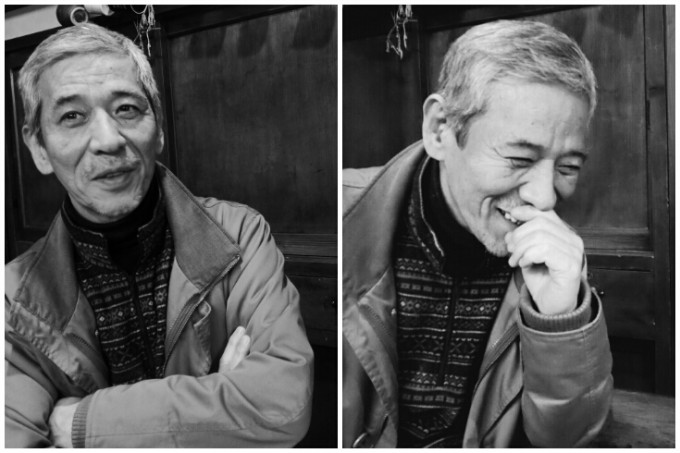
Motofumi, mid-interview (Photos: Johnny Wales)
Composer, arranger, fue (bamboo flute), koto (Japanese harp), shamisen (Japanese banjo-like stringed instrument), kokyu (Japanese violin), flute, cello and piano player Motofumi Yamaguchi was born in 1954 in Ibaraki Prefecture, just up the coast from Tokyo. His family moved to the big city when he was five years old. At high school and university (The Musashino Academy of Music) he studied Western classical music, composition, piano, cello and flute.
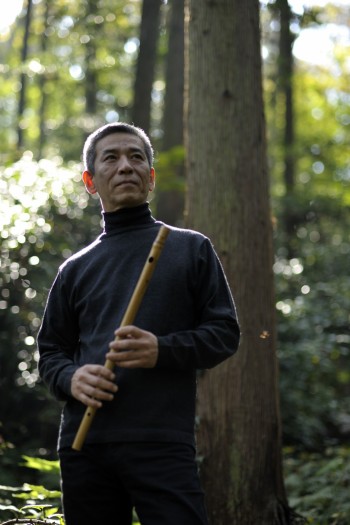
Photo: Takuro Susaki
In those days classical Japanese music was not generally held in very high regard among fellow students, and even some of the staff. It was seen as not quite as real as music from say, Germany or Italy. Motofumi began to feel this was very strange. Why shouldn’t Japanese have greater respect for their native culture? So he began seeking out performances of Noh and Kabuki, shamisen, koto and even Buddhist shomyo chanting. He was pleasantly surprised to discover that they felt very comfortable to him. He began to sense that he would be able to express himself more naturally in Japanese genres than Western. And so, at the age of 18, he began to study under shamisen (jiuta style) and koto teachers living nearby. He was surprised at how quickly he progressed and began to think that he had discovered a better, more natural direction for his career.
He was also beginning to tire of the big city and to dream of a life making music in the country. One day, while listening to his car radio, he heard vocalist and composer Ryudo Uzaki talking enthusiastically about his wonderful experience making music on Sado Island with a taiko group called Sado no Kuni Ondekoza. He talked about how amazing not only the taiko, but the koto and shamisen sounded too. Motofumi was fascinated and so went out and bought the two available Ondekoza records. They changed his life. As koto and shamisen were two of his instruments, he thought the group might have some use for him. He had heard about Ondekoza’s strict physical regimen and so decided to buy a bicycle. He would combine getting into shape with a 3-month holiday touring Japan. He quit his part-time job, drained his bank account and hit the road.
It was mid-November 1980 when he arrived unannounced at the group’s old wooden school house overlooking Mano Bay. After being reprimanded for not calling ahead, he was invited in and spent 3 days running at the crack of dawn, helping with cooking and cleaning and watching the group train. He returned to Tokyo with the understanding that he would move to Sado in January. Those were the days when there were no interviews, tests nor an apprentice system to join the group. If you showed up, demonstrated enough dedication and persistence, chances are you were in. Motofumi says with a chuckle that he (and quite a few other senior members) probably wouldn’t have gotten anywhere near the place under the current way of doing things!
This was just the time that Ondekoza was splitting off from the group’s founder Mr. Tagayasu Den, so things were in a great state of flux. Back in Tokyo, Motofumi met with Mr. Den and helped around the office for a week. Mr. Den suggested he learn the fue, and rather strangely, that he grow his beard. Motofumi followed his advice on the former matter and after arriving on Sado in the New Year he spent the next six months at the school house while the group toured, teaching himself the Japanese flute. It wasn’t long before he was touring with the group, something he carried on doing – including long stints as Musical Director – for the next 35 years.
Article in “SWITCH” Magazine
The latest issue of “SWITCH” magazine (Oct. 20) features interviews with cast members Yuichiro Funabashi and Masayuki Sakamoto about Kodo’s upcoming production, “Kodo One Earth Tour: Eternity.” (Article in Japanese/On sale in Japan) If you’re in Japan, we hope you’ll take a look.
Switch Official Website
Switch Vol. 32 No.11 Ringo Shina “Musician’s Counterattack”
(Published on October 20, 2014 by Switch Publishing)
Kodo “A New Style of Freedom”
“Two years have passed since Tamasaburo Bando assumed the role of Kodo’s artistic director. We snuck into the Kodo rehearsal hall, amidst an air of supple intensity.”
Yuichiro Funabashi: An Interview by Johnny Wales
Interview with Yuichiro Funabashi by Johnny Wales
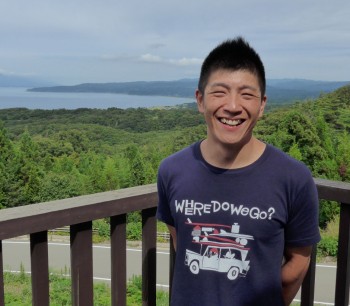
Yuichiro Funabashi (Photo: Johnny Wales)
Yuichiro Funabashi was born on May 9th, 1974 in Kanagawa Prefecture near Tokyo. He grew up in suburban Ninomiya. His father was a salary man and his mother worked in a hospital. He had one sister, 6 years older. He remembers his childhood fondly, describing himself as a life–of–the–party type playing soccer and baseball outside every day. Spinning tops were all the rage, (to put things in historical context) so there was plenty of that too. This was the very tail-end of the baby boom so there were children everywhere, 1,000 students alone in his elementary school, so there was no lack of friends to play with.
In middle school he joined the volleyball club. This became the centre of his world, 7 days a week, until he entered high school. Though his high school was nearby, it had even more students and he felt adrift among all the strange faces. Apart from dabbling in two wildly-divergent interests, American football and the tea ceremony, and some part-time work on archeological digs, he more or less coasted through 3 very dark years. In spite himself though, he did manage to get good enough marks to consider university. He was accepted into the Kyoto University of Art and Design where he studied archeology and artifact conservation. He enjoyed going on digs and he also became interested in marine archeology. It was while preparing for his scuba diving license that his life came to one of those great crossroads. Taiko entered his life.
“The Fukaura Schoolhouse” by Johnny Wales
Fukaura Gakusha – The Fukaura Schoolhouse
by Johnny Wales
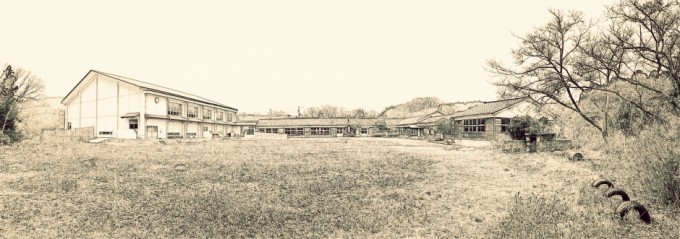
Welcome to Fukaura Gakusha (Fukaura Schoolhouse)
Not far from Kodo Village and perched high on the same ridge on Sado’s southern-most coast is the Fukaura Schoolhouse. This is where the first generation of Kodo members’ own children went to elementary and middle school, so it holds a special place in our hearts. Sadly, three years ago – as in so many other places in the Japanese countryside – it closed due to lack of young people to fill up its desks. Just a 15-minute walk down the road from the Sado Island Taiko Centre, a 15-minute drive from the port of Ogi, and 20 minutes to Sado’s largest sandy beach, this nostalgic wooden school in a grassy field is setting out on its second life. It will serve as a base for people coming to breath the air and experience first-hand what has made this magical island such a source of inspiration to us these forty years. Kodo’s dream has long been to not only bring the sights and sounds of Japan to the world but also to bring the world to Sado. We also want to do our part in giving back to the people of the island. Our busy lives here and on tour have meant that we haven’t been able to open Kodo Village to visitors except on special occasions. For those wanting to experience taiko here on the island the Sado Taiko Centre was built next to Kodo Village in 2007. There are no facilities for staying over though, so people were on their own when looking for a convenient place to stay. They say ‘When one door closes, another opens’, and so it is with the old Fukaura Schoolhouse. With the installation of modern bathrooms and conversion of some of the classrooms into dormitories with either tatami mats or bunk beds, we now have comfortable, if simple accommodations at a reasonable price for groups of up to 40 people, and it’s right down the road. Three meals a day are available featuring delicious home-made, seasonal, locally-sourced cuisine. A vegetarian or special dietary plan can also be arranged.

Inside Fukaura Gakusha (Fukaura Schoolhouse)
So if your group wants to experience the best of rural Japan – and while you are at it, drum your hearts out – here is the place to do it. Whether you are an experienced taiko group, have never even seen a Japanese drum and want to use a workshop as a team-building exercise, or you have a group of both veterans and beginners, one of Kodo’s veteran players can tailor a workshop to meet your needs.
“Taiko Drummers of Japan” on CBS News Sunday Morning
CBS News “Taiko Drummers of Japan”
On Aug. 3, Kodo & Earth Celebration were featured on CBS News “Sunday Morning.”
Check it out!
News: Article in “SINRA” Magazine
Article in “SINRA” Magazine
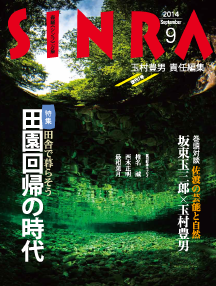
An interview with our artistic director Tamasaburo Bando and an article introducing Kodo are featured in the September 2014 issue of “SINRA” magazine. If you’re in Japan, we hope you’ll take a look.
SINRA WEB|http://sinraweb.jp/ (In Japanese)
“SINRA” September 2014 issue
Price: 1,200 yen (incl. sales tax)
On sale from July 24, 2014.
Tsuyoshi Maeda: An Interview by Johnny Wales
An Interview with Tsuyoshi Maeda by Johnny Wales
Tsuyoshi Maeda was born in the countryside near Kobe, Hyogo Prefecture on August 28th, 1986. He has one older sister. He fondly remembers a childhood playing in the surrounding foothills, fishing with friends from their small school with whom he remained close from kindergarten right through to middle school. Never keen on school work, Tsuyoshi played soccer and loved making music and art. At the age of 11 he joined the local children’s drum group, Hatakko Daiko. Learning taiko, fue, dance and song, it wasn’t long before Tsuyoshi knew that this is what he wanted to do with his life. Unusually, his parents supported that dream from the start. By high school his rehearsals and weekly performances with the group left too little time to carry on with soccer and he broadened his musical training by studying koto and (Japanese harp) shamisen (Japanese banjo) too.
He first came across Kodo in middle school through a CD which he listened to over and over. He went to see the group at a large concert in Kobe and decided then and there that he wanted to be like them. He remembers thinking that they seemed to shine on the stage.




